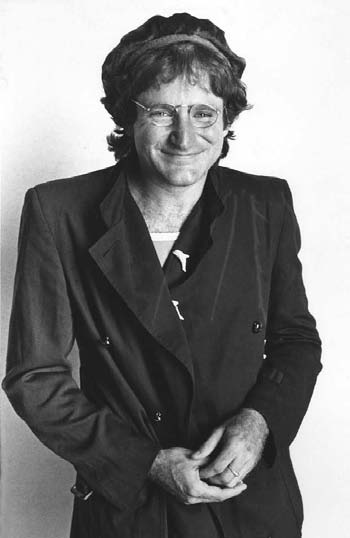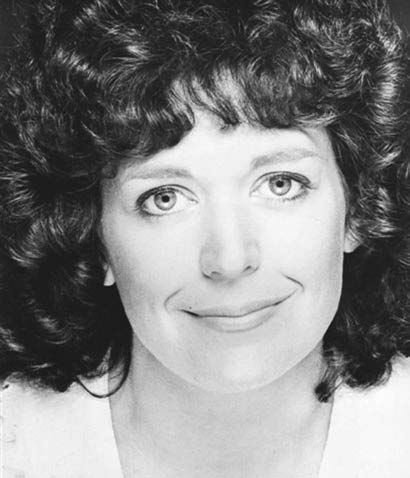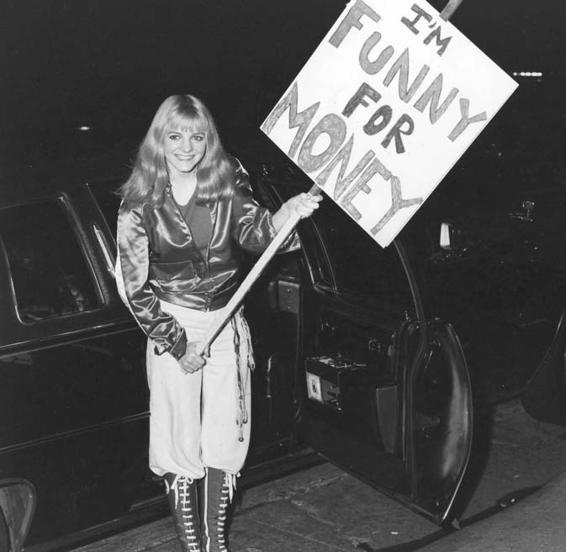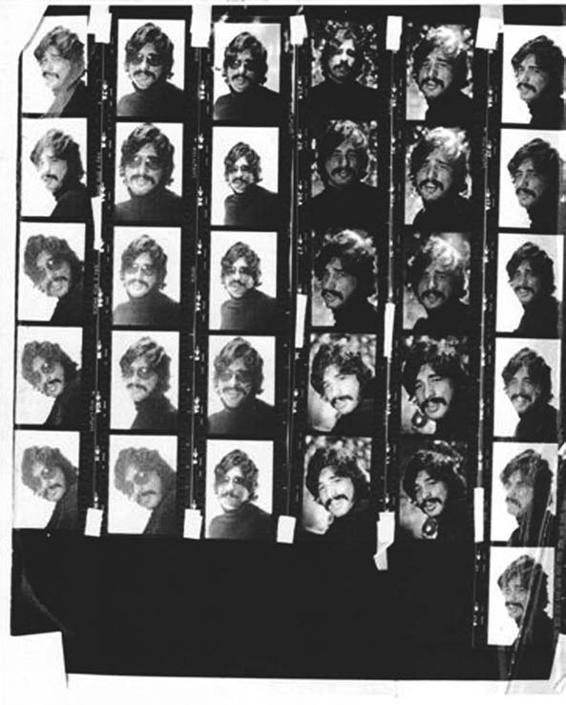I'm Dying Up Here: Heartbreak and High Times in Stand-Up Comedy's Golden Era by William Knoedelseder (21 page)
Authors: William Knoedelseder


1586483173 INSERT.qxd:Layout 1 6/10/09 1:08 PM Page 9
Elayne Boosler, relaxing in her West Hollywood apartment in May 1979.
Photo by William Knoedelseder.
Robin Williams mugs for Budd Friedman
(with his trademark monocle).
Courtesy of Budd Friedman.
Robin Williams, photographed in his
street clothes just prior to the debut of
Mork and Mindy
.
Photo by William Knoedelseder.


1586483173 INSERT.qxd:Layout 1 6/10/09 1:08 PM Page 10
Dottie Archibald, housewife
turned standup comic turned strike
organizer. She served as the model
for Sally Field’s character in the
1988 movie
Punchline
(with Tom
Hanks), which was written by
David Seltzer, her former neighbor
in Ojai, California.
Little girl on the picket line: Teenage TV star Alison Arngrim (
Little House on
the Prairie
) joins her fellow strikers outside the Comedy Store. Courtesy of Alison Arngrim.

1586483173 INSERT.qxd:Layout 1 6/10/09 1:08 PM Page 11
Putting it all on the line, April 1979: Jo Anne Astrow (kneeling, second from left); Steve Lubetkin (kneeling far right, holding the “Yuk Stops Here” sign); Mark Lonow (second row, second from left, leaning); Dottie Archibald (second row, in white tunic, holding the
“I said I wanna be a star” sign); Tom Dreesen (third row, far left, wearing Chicago Cubs jacket); and Ollie Joe Prater (back row, far left, in plaid shirt). Photo by Rick Bursky.

1586483173 INSERT.qxd:Layout 1 6/10/09 1:08 PM Page 12
Contact sheet for Steve Lubetkin’s professional head shots, circa 1976.
Courtesy of Barry Lubetkin.
1586483173 text_rev.qxd:Layout 1 5/19/09 1:55 PM Page 135
Order, Please
The late-night coke sessions at Mitzi Shore’s house did more than separate the haves from the have-nots, the pets from the peons. They served to further distance the men from the women since Shore was the only female who attended.
The women comics weren’t bothered so much about not being invited—coke was mostly a guy thing back then—as they were about the fact that Mitzi participated. In the winter of 1979, the so-called women’s movement was in full roar. All across the country, supporters were pushing hard for states to ratify an equal rights amendment to the U.S. Constitution. And yet, here was a woman in a unique position of power, supposedly the champion of female stand-up comedy, having affairs and sharing drugs with her male employees, one of whom, Mike Binder, wasn’t even old enough to drink legally. These weren’t the sort of equal rights they had in mind. If Mitzi were a man, they’d want her arrested.
What’s more, Shore’s grand plan for providing female comics with a level playing field in the form of the “ladies-only” Belly Room wasn’t working out as originally envisioned.
With seating for about fifty and its own entrance from the parking, the Belly Room looked pretty much like the rest of the 135
1586483173 text_rev.qxd:Layout 1 5/19/09 1:55 PM Page 136
136
William Knoedelseder
Comedy Store—black on black on black—with the exception of a red satin heart that Shore affixed to one wall. When the heart disappeared one day, Shore posted a notice on the Comedy Store bulletin board announcing that it had been stolen by her daughter, Sandi. “And I want it returned,” she wrote. “So if anyone sees her, tell her to put it back.”
There were about twenty women who worked the Belly Room regularly. Elayne Boosler and Marsha Warfield, the two women with the most polished acts, kept their vows not to perform there.
For some of the others, the Belly Room proved to be pretty much what Mitzi had promised: a space removed from the rat-a-tat-tat, rim-shot rhythm of the Original Room, where they could find a distinctly female voice and develop a unique style at a comfortable pace. It was a room where they could be bad, fall down, and fail without fear of wrecking their careers. In fact, Judy Carter did fall down onstage one night, twisting her ankle so badly that she had trouble getting up. In pain, she called out to the audience for help but people just sat there smiling, waiting to see how the bit was going to pay off. The Belly Room was more free-form than the Original Room, more experimental.
“It was a jazzy atmosphere,” Sandra Bernhard told writer Law -
rence Christon years later. “The great thing about that space is that people looked for the unusual. It gave me the opportunity to explore and express myself.”
Bernhard and Lotus Weinstock were the two performers who used the Belly Room to the best advantage. As the eldest comic in residence, Weinstock functioned as the room’s soulful den mother, sometimes emceeing in her bathrobe. Bernhard was her onstage opposite, the brash (to say the least) young newcomer whose intentionally obnoxious persona had often caused walkouts when she performed in the Original Room. The opposites eventually attracted, and the two teamed up to produce some memorable moments in the Belly Room.
1586483173 text_rev.qxd:Layout 1 5/19/09 1:55 PM Page 137
I’m Dying Up Here
137
“I’ve spent fifteen years transcending my anger, and dealing with you it all comes back in one night,” Weinstock would say as they launched into a ferocious onstage cat fight—grabbing onto one another, pulling hair, yowling, wrestling to the floor, and rolling around on the stage. Then, Bernhard would suddenly leap to her feet and say breathlessly, “I feel so
close
to you.”
Shore loved the two of them, especially Bernhard, whom she thought was destined for stardom because she was so different from anyone else, and she let them have as much stage time as they wanted. On weekends, they often did an hour-long set, which didn’t sit well with their comedy sisters because it meant fewer time slots to go around, and most of the women hadn’t been given any spots in either the Original Room or at Westwood since the Belly Room opened. Only Elayne Boosler, Marsha Warfield, Shirley Hemphill, and Lois Bromfield, another Mitzi favorite, were getting spots in the bigger rooms, which males now dominated even more than before. The Belly Room was functioning as an overflow space. When the other rooms were full, the doormen directed people up the back stairs to be entertained by the females until the next show of male comics began. Many of the women thought they were being treated as a third-rate attraction (at least the belly dancers of yesteryear got paid). Intentionally or not, in the name of equality, they were being discriminated against.
The growing disenchantment among the women about opportunity dovetailed with that of the men over the issue of pay. And it all came together in a series of unexpected phone calls that invariably went something like this:
“There’s going to be a meeting of all the comics on Thursday at the union hall [International Alliance of Theater and Stage Employees] on Sunset.”
“
All
the comics? What for? ”
“As many as we can get. We’re gonna talk about getting paid for our performances at the Store.”
1586483173 text_rev.qxd:Layout 1 5/19/09 1:55 PM Page 138
138
William Knoedelseder
“Wow! What time Thursday? ”
“Two o’clock.”
(Pause)
“Is that a.m. or p.m.? ”
About seventy-five comics, including nearly all the women, showed up that Thursday afternoon for what may have been the largest-ever gathering of stand-ups outside of a Friars Club roast.
Alison Arngrim cut her afternoon classes at Hollywood High to attend. She figured that a meeting of comedians trying to get organized about anything was bound to be hilarious, like spending the afternoon in a great big fuckup class. Her comrades didn’t disappoint her. Chaos reigned at the outset, with everyone shouting and trying to talk at the same time. When someone called out,
“Order please,” half a dozen voices from around the room hollered back in unison, “Cheeseburger, fries, and a coke.”
Jay Leno tried to frame the discussion but couldn’t keep from telling jokes or refrain from responding to heckles. It was a repeat of what happened at Boosler’s apartment, but much worse, ca-cophony cubed. Finally, Tom Dreesen couldn’t take it any more.
He got up from his seat and walked to where Leno stood in the front of the room. Raising his hand for attention, he started talking above the din.
“Guys,
guys
, I know it’s a lot of fun being all together like this, but we really have some important things to talk about today, and it would be better and more effective if we got a little organized about it and spoke one at a time,” he said.
Knowing the basics of Roberts Rules of Order, he tried to apply them to get the crowd quieted down and focused. “Okay, the chair recognizes Jay Leno. Jay, you have the floor; make your point. Gallagher, please sit down and be quiet.”
Dreesen’s stature as the most experienced comic in the room and his reputation as a mensch helped overcome the fact that Leno stood behind him throughout the meeting, miming his every 1586483173 text_rev.qxd:Layout 1 5/19/09 1:55 PM Page 139
I’m Dying Up Here
139
word and gesture as if signing for the deaf. The meeting was ostensibly about money, but the discussion turned mostly on Mitzi, with opinion quickly dividing into two camps. The she-owes-us group argued, “She’s making millions and should share some of it with us.” The we-owe-her faction countered with, “We should just be grateful that she lets us perform at the Store.”
